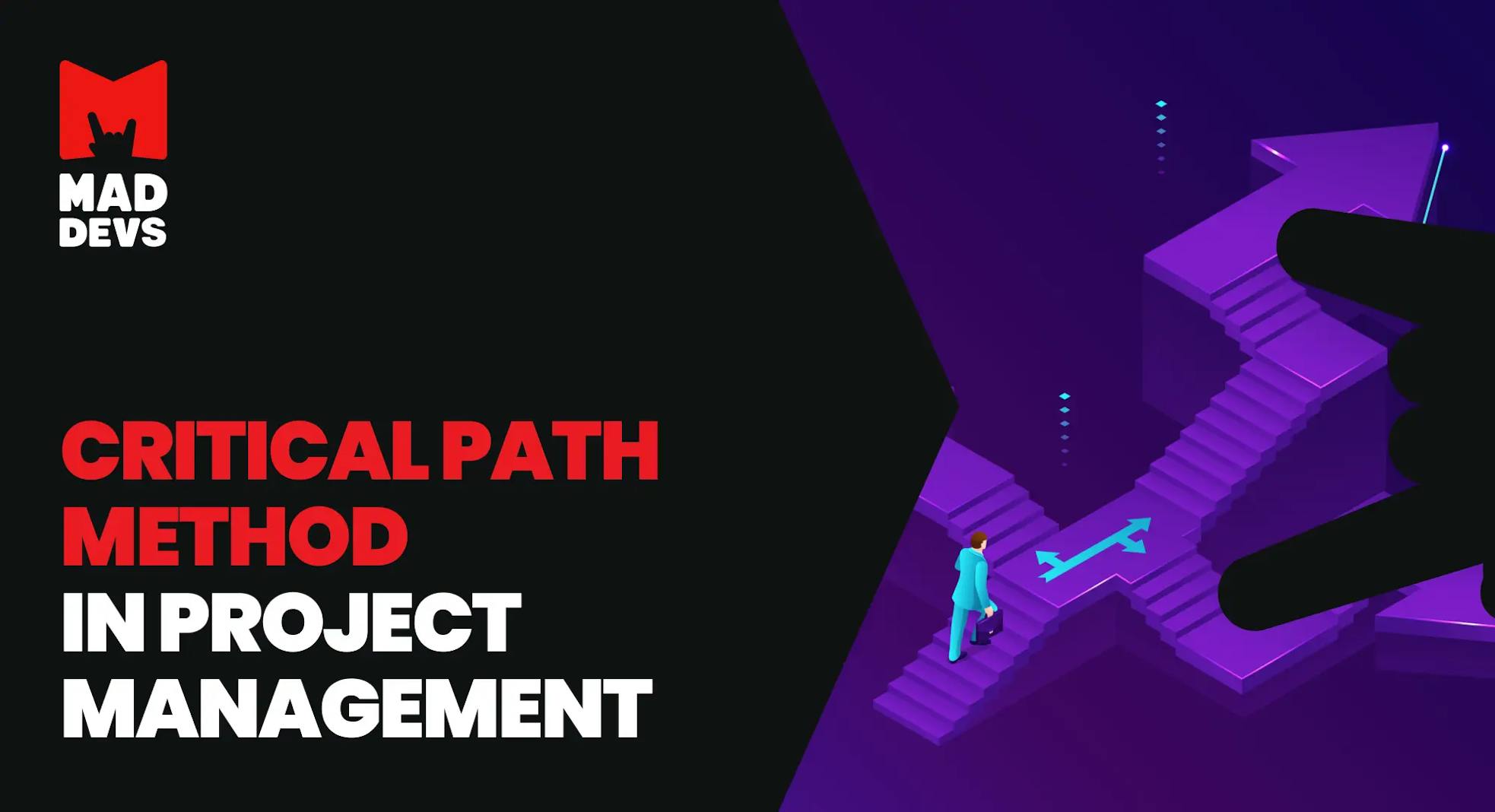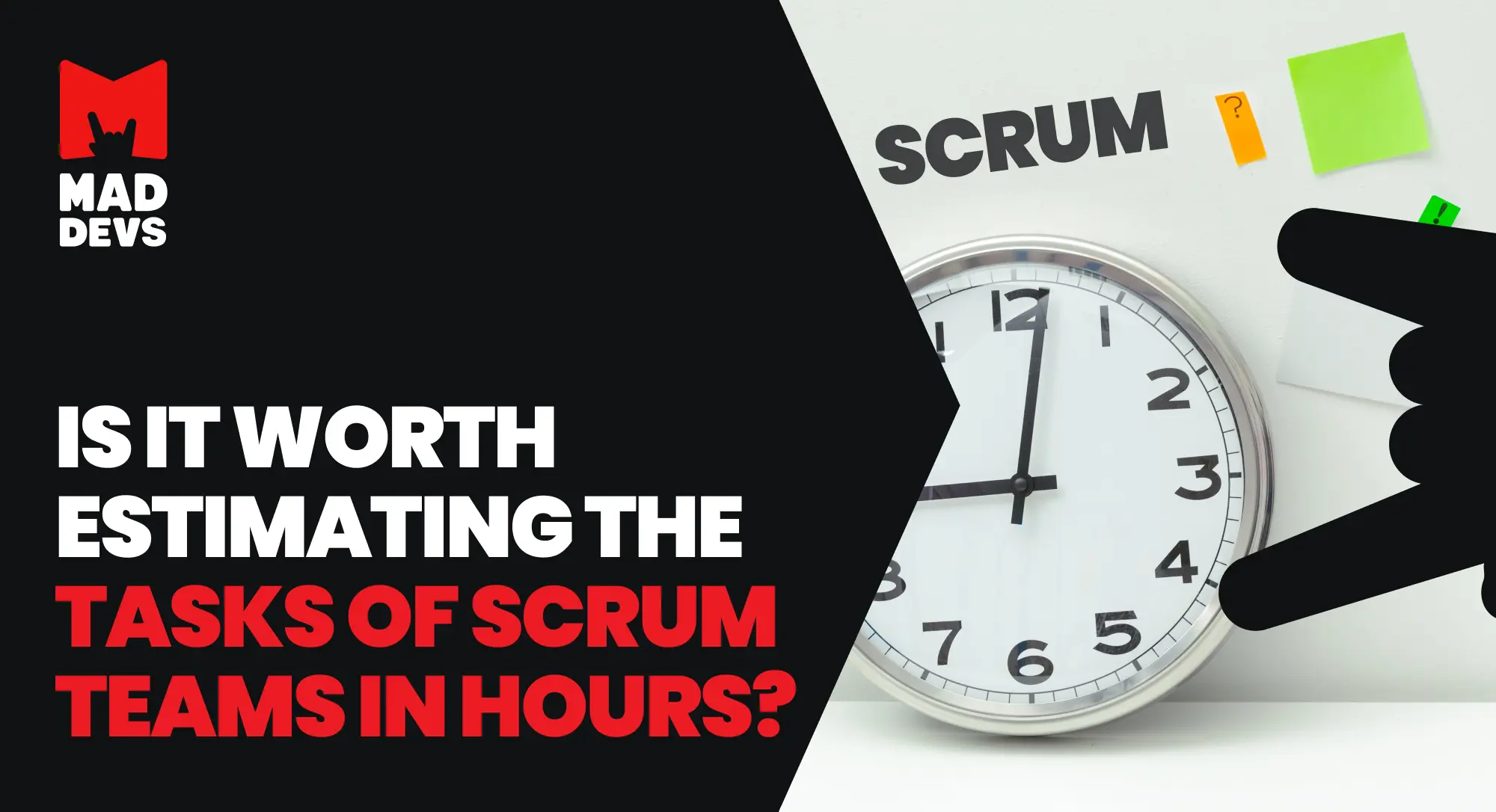Proper project management is just as essential to a product's success as powerful technology or an ingenious idea, which is why the field is continuously advancing to provide teams with new techniques and tools for improved and more profitable development.
One such advancement was the critical path method (CPM), which we'll explore in this article. We'll explain in detail its purpose, the benefits of using CPM, its limitations, and key considerations for its implementation so you have a clear understanding of how CPM can streamline project management, reduce costs, and improve overall project outcomes.
What is CPM?
The critical path method (CPM) is a project management technique that provides a structured framework for planning, scheduling, and managing complex projects with many dependencies between the tasks. By identifying the critical path, which represents the sequence of tasks that must be done on time for the project to be completed on schedule, project managers can prioritize their efforts and ensure timely completion.
Importance of the critical path method
The CPM has played a crucial role in developing project management as a discipline. It first emerged in the late 1950s as part of the larger Program Evaluation and Review Technique (PERT), which was developed to help manage the U.S. Navy’s time-sensitive projects. It’s often used for managing large projects with floating task deadlines and considering unexpected factors.
PERT spawned other approaches to match different projects, and CPM was one of them. It’s used in a number of other industries where missing deadlines or not completing tasks in the right order can have serious safety and cost implications.
For example, in the construction industry, CPM is essential for managing the many interdependent tasks involved in building projects, such as site preparation, excavation, foundation work, and superstructure construction. In the healthcare industry, CPM manages the many complex tasks involved in developing new drugs, from early-stage research to clinical trials and regulatory approval. CPM helps engineers manage engine components' design, testing, and production in mechanical engineering.
Critical path method vs. PERT
While PERT is CPM's predecessor, they are two distinct approaches to project management with key differences between them:
| PERT | CPM |
|---|---|
|
|
Another approach is critical chain method (CCM). You can uncover the key differences between these two methodologies and learn which one might be more beneficial for a project with our article "Critical Chain vs. Critical Path in Project Management". Or you can contact Mad Devs' project managers to unlock our expertise and find the best approach for your project.
Read on for a breakdown of the benefits and limitations of CPM.
Critical path method benefits and limitations
CPM benefits
Projects can reap many benefits from CPM, such as:
➕ Improve team communication
The foundation of effective CPM is the involvement of people from across the project team to identify the critical path (the most important tasks in a project). This encourages clear communication in which team members understand that their input is essential to creating the most accurate visualization of the project. As a result, everyone feels involved and knows their contribution will lead to greater project efficiency and quality.
➕ Precise planning
CPM enables project managers to identify a project's critical path and prioritize the most important tasks. This leads to a more realistic project schedule that allows teams to allocate resources more efficiently and ultimately deliver the project on time and within budget because you'll have extra room for any tasks that require more resources or issues that come up during the project. Even though you may not finish all your tasks, you'll know that you've completed the ones that are most critical to the project.
➕ Visualize project dynamics
CPM provides a clear visual representation of a project and its dependencies that is easy for team members, stakeholders, and customers to understand. This improves communication and decision-making throughout the project and reduces the chances of misunderstandings or misinterpretations of goals and processes.
➕ Early detection of potential delays
CPM helps identify potential delays early in the project, so project managers can take corrective action before the issue becomes critical. This increases the chances of completing the project on time and within budget, keeping stakeholders at all levels happy.
➕ Resource optimization
CPM helps optimize resource usage by determining which tasks are critical and which can be deferred. This ensures that the project is completed with the most efficient utilization of resources, reducing the chances of overallocation or underutilization.
➕ Improved risk management
CPM helps identify risks and uncertainties that may affect project duration. Using this information, project managers can develop risk mitigation strategies and contingency plans, ensuring that the project is completed on time and within budget, which increases stakeholder satisfaction and can ultimately result in future project opportunities.
CPM limitations
While CPM is a widely-used and effective project management technique, it not without its drawbacks. Here are some potential limitations of using CPM:
➖ Complex
Implementing CPM can be complex, especially for larger projects with many activities and dependencies that need to be broken down into smaller tasks. It requires extensive planning and coordination of team members and stakeholders to ensure that all the activities are properly identified and linked. Beginners will find it challenging to manage CPM at first without proper guidance and support.
➖ Time-consuming
Identifying all the activities and their dependencies can be time-consuming and may require significant resources to complete the project on time. This involves communicating with as many stakeholders as possible. You'll also have to repeat the process if any changes are made to account for the alterations.
➖ Assumes all activities are known
CPM assumes that a team knows all the activities and their durations with certainty, which may not always be the case in real-world projects. Unknown factors and unexpected events can affect the accuracy of CPM-based schedules.
➖ Rigid
Once the critical path has been identified, it becomes difficult to change the project plan without affecting the overall schedule. This rigidity can make adjusting to changes in project scope, timelines, or resources difficult and time-consuming. Adjustments require a reassessment of the critical path and essential tasks.
➖ Doesn't account for resource constraints
CPM assumes that all the necessary resources are available to complete a project, but in reality, they may be limited. It also doesn't identify overlap of resource uses for different tasks within the project. This can lead to delays or overburdening of resources, which can affect the project's schedule.
➖ May not account for non-critical tasks
CPM prioritizes critical tasks and does not account for non-critical tasks that may still impact a project's success. Neglecting non-critical tasks may lead to issues with quality, stakeholder management, or other important aspects of the project.
CPM can be an effective project management technique, though it's important to be aware of its limitations and potential drawbacks when deciding whether to use it for a particular project.
How to use the critical path method?
CPM is a statistical method that uses a deterministic model to plan and control well-defined actions. It's also used to identify the critical path, which is the sequence of tasks that must be completed on time to ensure the project is completed by the target completion date.
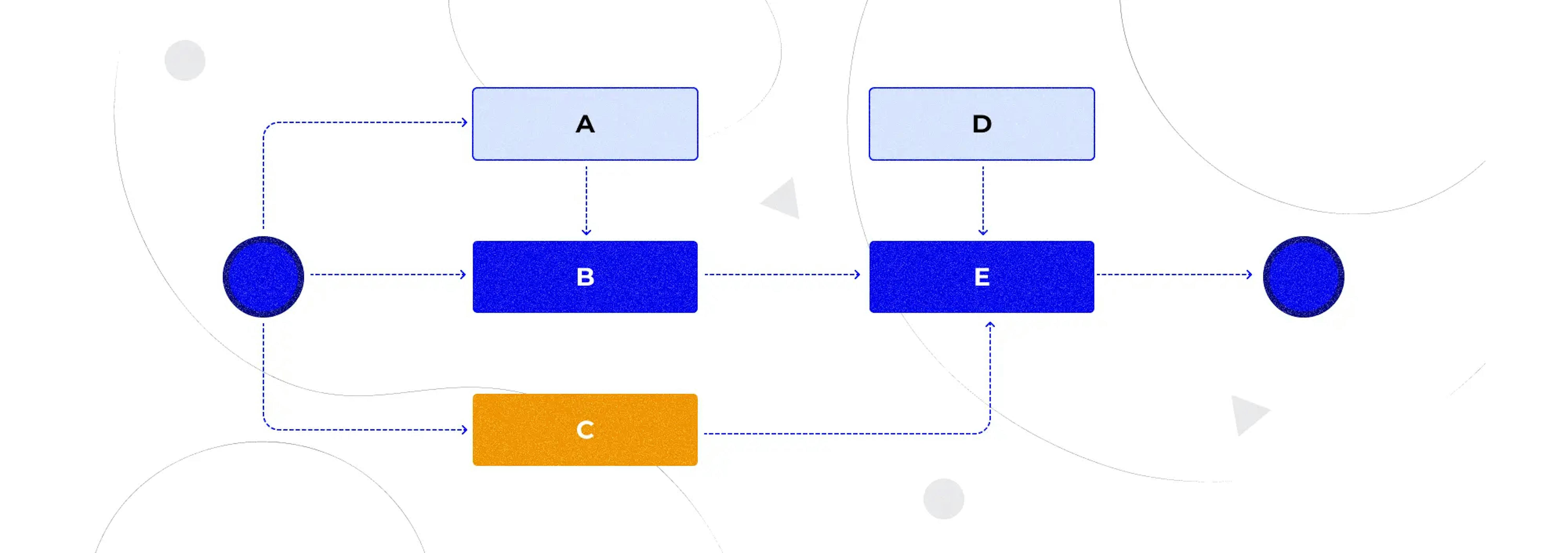
However, CPM's deterministic approach may not accurately represent the project timeline for projects that involve a large degree of uncertainty. As discussed earlier, PERT may be a better choice in these cases.
A crucial component of CPM is the work breakdown structure (WBS), which enables project managers to break down a project into smaller, manageable parts. WBS provides a clear and organized overview of a project's scope, ensuring no critical tasks are missed. This helps to identify and define all the tasks and work items required to complete the project successfully.
What elements does CPM include?
In addition to WBS, CPM incorporates a few other key concepts.
- Project activity list
The project activity list is a comprehensive list of all the tasks and work items required to complete the project. The project activity list is used to create WBS and is the foundation for the project network diagram. - The project network diagram
The project network diagram is a graphical representation of the project schedule that shows the interdependencies between tasks. It calculates the critical path and determines the float/slack for each task. - Project duration
Project duration is the time required to complete a project. Project duration is a critical factor in CPM as it directly impacts the budget and overall success. - Resource constraints on the project schedule
Resource constraints, such as limited availability of personnel, equipment, or materials, can impact the duration of tasks and ultimately affect the overall project timeline. - Early start and early finish
Early start and early finish are a task's earliest possible start and finish times based on the project schedule and the interdependencies between tasks. These times provide project managers with a baseline for the project schedule and are used to determine the critical path. - Late start and late finish
Late start and late Finish are a task's latest possible start and finish times based on the project schedule and the interdependencies between tasks. Late Start and Late Finish provide project managers with an understanding of the flexibility in the project schedule and are used to determine float/slack. - Float/slack
Float/slack refers to the time a task can be delayed without affecting the overall project timeline. It is the difference between a task's Late Start and Early Start or a task's Late Finish and Early Finish. Understanding float/slack is important in CPM as it gives project managers a buffer to allow for unexpected events or changes to the project schedule.
How to calculate critical path?
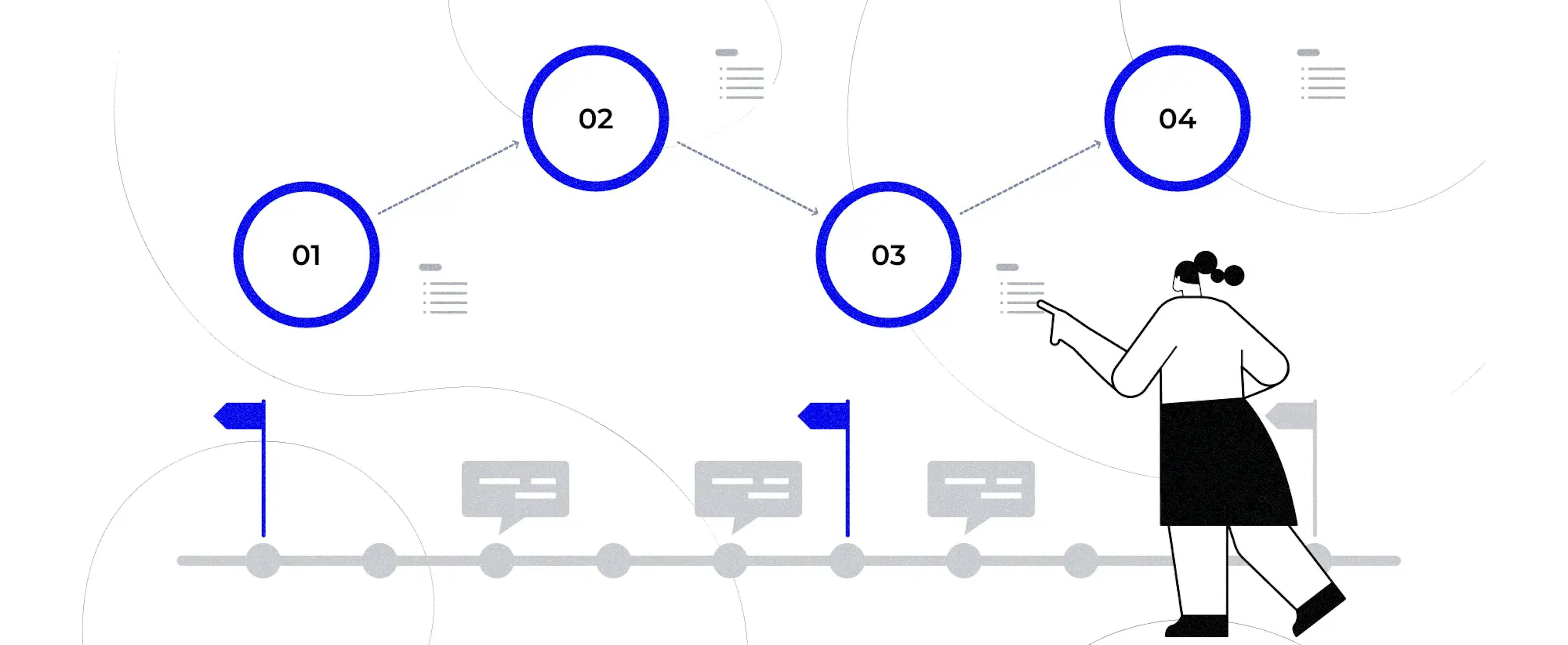
Step 1. List all tasks and estimate their duration
Break down the project into smaller, more manageable components using a WBS. Estimate the duration of each task in the list using expert judgment, historical data, or a combination of both.
Step 2. Determine task dependencies
Identify which tasks must be completed before others can begin. Represent the dependencies using arrows, with the tail pointing to the task that must be completed first and the head pointing to the dependent task.
Step 3. Create the project network diagram
Arrange tasks and their dependencies in a graphical format using a network diagramming tool like Microsoft Project or a flowcharting tool like Visio. The network diagram shows the interdependencies between tasks and the critical path.
Step 4. Calculate the earliest start and finish times
Calculate the earliest start time (ES) and earliest finish time (EF) for each task by using the formula ES = Max (EF of preceding task) and EF = ES + duration of the task.
Step 5. Calculate the latest start and finish times
Calculate the latest start time (LS) and latest finish time (LF) for each task by using the formula LF = Min (LS of subsequent task) and LS = LF - duration of the task.
Step 6. Identify critical path tasks
Tasks with zero total slack (TS = LS - ES) are on the critical path. The critical path is the longest sequence of tasks that must be completed in order to complete the project on time.
Step 7. Update the project network diagram
Use the critical path information to update the project network diagram, which is used to monitor the progress of the project and make any necessary adjustments to the schedule.
How to work with parallel tasks in CPM?
As we said before, CPM works great with the exact calculation of when tasks begin and end, considering their dependencies and ensuring a strict and necessary order of execution. But what if the tasks in your project don't go one by one, and you need to do some of them in parallel? As promised, we will recommend changing the standard CPM approach and getting around this limitation. To build a CPM with tasks that have dependencies but can work in parallel and be integrated at the end, you can follow these steps:
Identify all the tasks required to complete the project and their dependencies using WBS.
Determine the duration of each task and whether they can be performed in parallel. Parallel tasks can be shown as separate paths on the network diagram.
Create a network diagram that shows all the tasks and their dependencies. The diagram shows parallel tasks as separate paths that merge back together once the parallel activities are complete.
Determine the earliest start and finish times for each task by working forward from the project start date, taking into account the duration of each task and its dependencies.
Determine each task's latest start and finish times by working backward from the project end date, considering the critical path.
Identify the critical path, which is the sequence of tasks with the longest total duration. Any delay in completing a task on the critical path will delay the entire project.
Monitor the progress of the critical path tasks and take action to keep them on schedule.
Once the parallel tasks are complete, integrate them back into the main critical path.
Note that when creating a CPM with parallel tasks, it’s crucial to identify the dependencies between the tasks and their durations properly. This will allow you to accurately determine the critical path and allocate resources efficiently to keep the project on schedule.
An example of critical path in project management
We’ll take the example of making a website. The process will be simplified to provide a clearer understanding of how CPM helps organize the project.
📕 Interested in learning more about developing software step by step? Check out our book, Software Development Approaches, in which we share the best development practices we've gathered, implemented, and improved over many years of experience.
List all tasks and estimate their duration
- Gather the requirements (2 days)
- Create a design mockup (3 days)
- Develop an HTML markup (4 days)
- Develop CSS styles (4 days)
- Develop JavaScript functionality (5 days)
- Test and debug (3 days)
- Set up server infrastructure (2 days)
- Develop server-side code (6 days)
- Integrate front-end and back-end (3 days)
- Test server-side functionality (3 days)
- Deploy the website to a server (1 day)
Determine task dependencies
- Gather requirements has no dependencies
- Creating design mockup depends on gather requirements
- Developing HTML markup depends on create design mockup
- Developing CSS styles depends on create design mockup
- Developing JavaScript functionality depends on developing HTML markup and developing CSS styles
- Test and debug depend on develop JavaScript functionality
- Integrate front-end and back-end depends on developing server-side code and developing JavaScript functionality
- Test server-side functionality depends on Integrate front-end and back-end
- Deploy the website to the server depends on test server-side functionality
Create the project network diagram
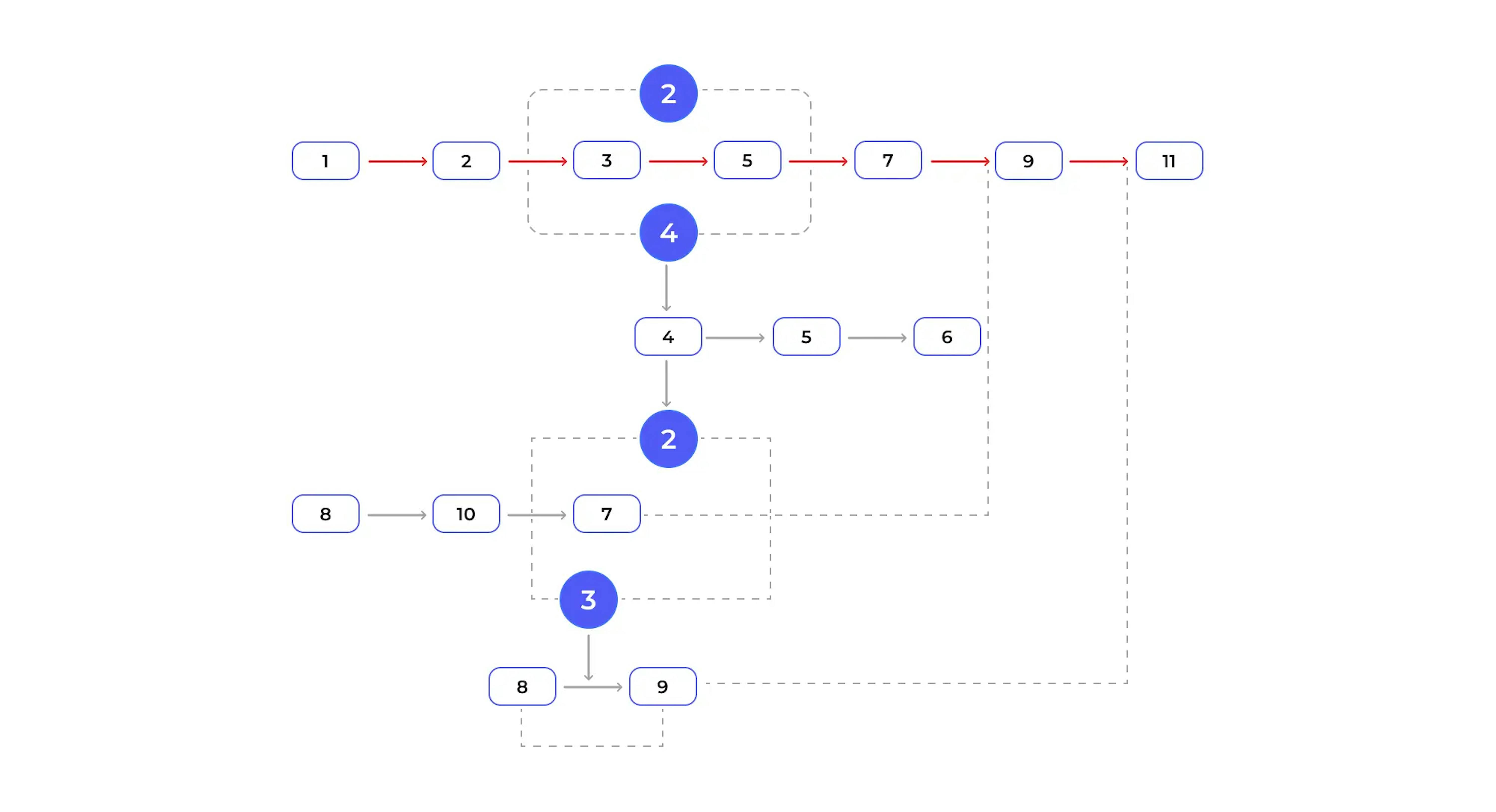
Calculate the earliest start and finish times
| Tasks | Earliest start (days) | Finish times (days) |
|---|---|---|
| Gather requirements | 0 | 2 |
| Create design mockup | 2 | 5 |
| Develop HTML markup | 5 | 9 |
| Develop CSS styles | 5 | 9 |
| Develop JavaScript functionality | 9 | 14 |
| Test and debug | 14 | 17 |
| Set up server infrastructure | 17 | 19 |
| Develop server-side code | 19 | 25 |
| Integrate frontend and backend | 14 | 17 |
| Test server-side functionality | 17 | 20 |
| Deploy the website to the server | 20 | 21 |
Calculate the latest start and finish times
| Tasks | Latest finish (days) | Latest start (days) |
|---|---|---|
| Develop server-side code | 26 | 20 |
| Set up server infrastructure | 21 | 17 |
| Test and debug | 20 | 17 |
| Develop JavaScript functionality | 19 | 14 |
| Develop CSS styles | 13 | 9 |
| Develop HTML markup | 13 | 5 |
| Create design mockup | 4 | 2 |
| Gather requirements | 2 | 0 |
Calculate the total slack
- Gather requirements:
TS = LF - EF = 0 - Create design mockup:
TS = LF - EF = 0 - Develop HTML markup:
TS = LF - EF = 0 - Develop CSS styles:
TS = LF - EF = 0 - Develop JavaScript functionality:
TS = LF - EF = 0 - Test and debug:
TS = LF - EF = 0 - Set up server infrastructure:
TS = LF - EF = 0 - Develop server-side code:
TS = LF - EF = 1 - Integrate frontend and backend:
TS = LF - EF = 0 - Test server-side functionality:
TS = LF - EF = 0 - Deploy the website to the server:
TS = LF - EF = 0
Identify critical path tasks
The critical path for this project includes tasks 1, 2, 3, 4, 5, 6, 7, 10, and 11, which have zero total slack.
Update the project network diagram
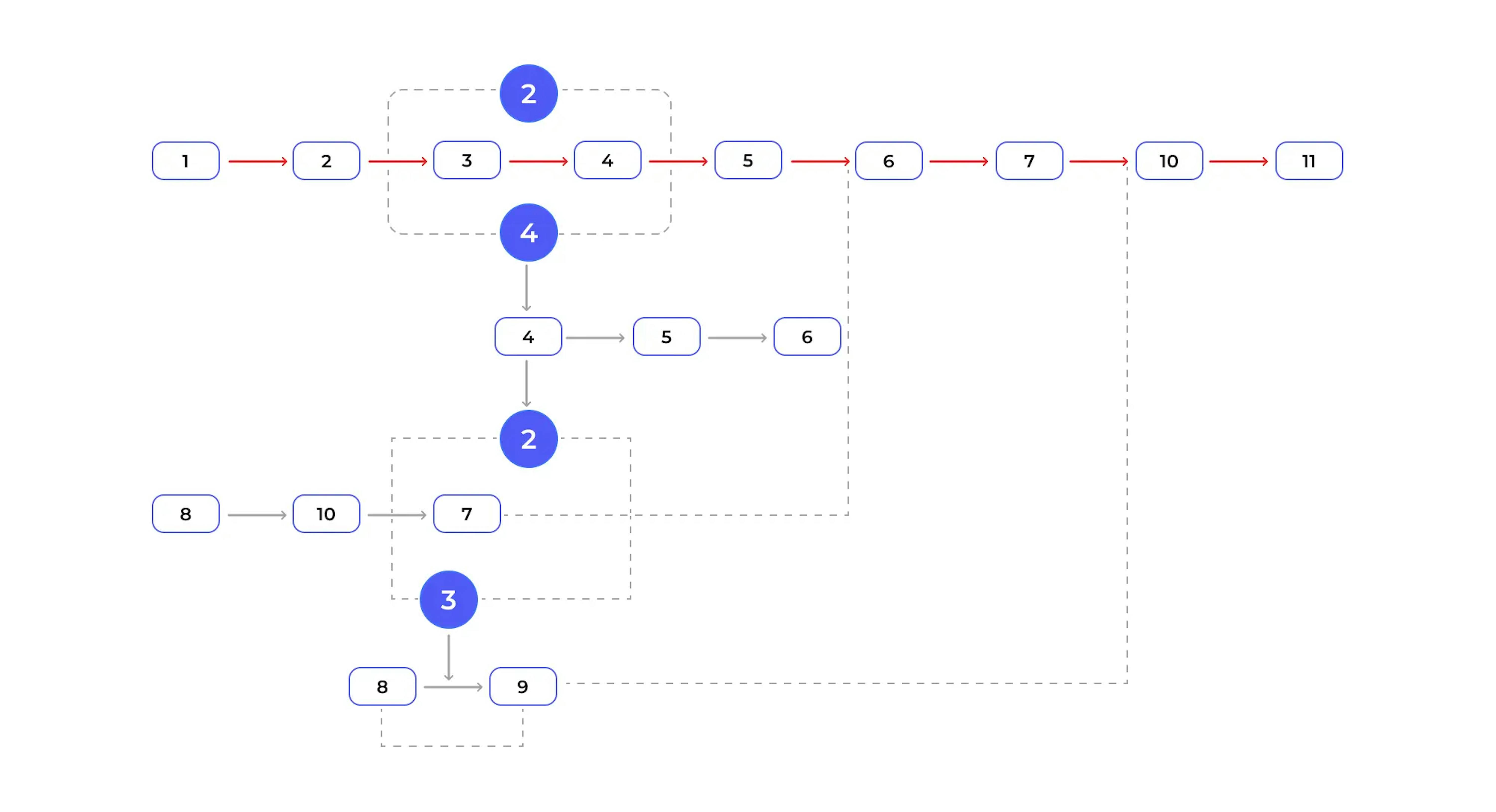
Now you have a diagram including all the tasks and reflecting their dependencies, as well as the obvious critical path that needs special attention in development. Such a calculation and its visual representation will greatly help manage the project in the most obvious way, avoiding downtime and broken deadlines.
Summary
Now you know what CPM is and why it is so important. CPM helps software development professionals to manage projects more effectively by breaking down the project into smaller, more manageable components and focusing on the critical path. By using CPM, you can anticipate potential delays, make informed decisions about resource allocation, budgeting, and scheduling, and keep your project on track.
Also, you now know exactly when and how to use it. CPM can be applied to all phases of software development, including planning, design, development, testing, and deployment. Identifying task dependencies and parallel activities can shorten the project's duration and improve overall efficiency.
And if you still have questions, ask for our free consultation. Our experts will carefully review your project and select the most suitable techniques and tools for its management, ensuring the highest quality and benefit from the final product.

